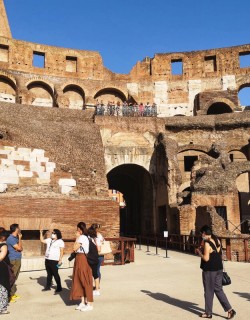Located in the northern part of Rome is perhaps one of the more significant, yet lesser known (or somewhat overlooked) landmarks of the Roman Empire, Ponte Milvio or the Milvian Bridge. Originally constructed of stone in the 2nd century by Gaius Claudius Nero, a Roman consul, it was the setting of the Battle of Milvian Bridge, fought between Constantine I and Maxitius in the year 312, of which Constantine I was victorious. The battle is famously depicted in the fresco “The Battle of the Milvian Bridge” (1520-1524) by Italian painter and architect, Giulio Romano. This spectacular piece of art was painted under the guidance of Raphael (until his death in 1520), and is on display in the Vatican Museums. It is highlighted during our in-depth Vatican Museums tour, which also includes the Sistine Chapel and St Peter’s Basilica.
The bridge, which spans across the Tiber River, was repaired and modified many times throughout its history, most notably in 1850 after it was intentionally damaged by Giuseppe Garibaldi’s army in an attempt to prevent advances by the French during the French invasion. Historically, the bridge itself has also been noted as a place of romance for Romans. As the great Roman historian and senator, Tacitus, states in his book “The Annals,” Ponte Milvio was “famous for its nocturnal attractions,” also pointing out that Emperor Nero “was in the habit of frequenting it” specifically for these “attractions”.
In modern times, Ponte Milvio gained increased popularity in Rome around 2006, when the book “Ho Voglia Di Te” or “I Want You” was released, telling a romantic story about young lovers in Rome. The story influenced many couples to visit the bridge to attach padlocks to parts of the bridge, then tossing the key into the Tiber River as a declaration of everlasting love. In 2007, the book was adapted to the big screen, thus spreading this new “tradition” worldwide as tourists followed suit.
In 2012, after years of accumulation, all the padlocks were removed due to concerns about the extra stress placed on the historic bridge’s structural integrity. Currently, locks are still latched to the bridge; however they are removed on a fairly regular basis.
~by Michele D’Elia~


